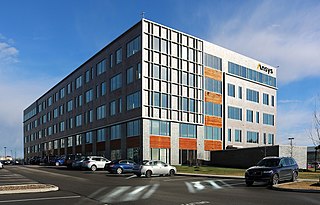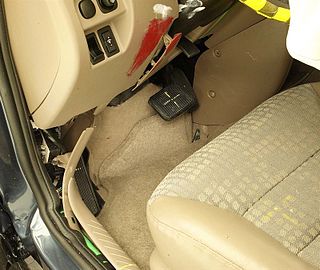Related Research Articles
A simulation is an approximate imitation of the operation of a process or system; that represents its operation over time.

Crumple zones, crush zones, or crash zones, are a structural safety feature used in vehicles, mainly in automobiles, to increase the time over which a change in velocity occurs from the impact during a collision by controlled deformation; in recent years also incorporated into trains and railcars.

A crash test is a form of destructive testing usually performed in order to ensure safe design standards in crashworthiness and crash compatibility for various modes of transportation or related systems and components.
Automotive engineering, along with aerospace engineering and naval architecture, is a branch of vehicle engineering, incorporating elements of mechanical, electrical, electronic, software, and safety engineering as applied to the design, manufacture and operation of motorcycles, automobiles, and trucks and their respective engineering subsystems. It also includes modification of vehicles. Manufacturing domain deals with the creation and assembling the whole parts of automobiles is also included in it. The automotive engineering field is research -intensive and involves direct application of mathematical models and formulas. The study of automotive engineering is to design, develop, fabricate, and test vehicles or vehicle components from the concept stage to production stage. Production, development, and manufacturing are the three major functions in this field.

The European New Car Assessment Programme is a European car safety performance assessment programme based in Leuven (Belgium) and founded in 1996 by the Transport Research Laboratory for the UK Department for Transport and backed by several European governments, as well as by the European Union. Their slogan is "For Safer Cars".

LS-DYNA is an advanced general-purpose multiphysics simulation software package developed by the Livermore Software Technology Corporation (LSTC). While the package continues to contain more and more possibilities for the calculation of many complex, real world problems, its origins and core-competency lie in highly nonlinear transient dynamic finite element analysis (FEA) using explicit time integration. LS-DYNA is used by the automobile, aerospace, construction and civil engineering, military, manufacturing, and bioengineering industries.

Ansys Inc. is an American public company based in Canonsburg, Pennsylvania. It develops and markets engineering simulation software. Ansys software is used to design products and semiconductors, as well as to create simulations that test a product's durability, temperature distribution, fluid movements, and electromagnetic properties.

Side collisions are vehicle crashes where the side of one or more vehicles is impacted. These crashes often occur at intersections, in parking lots, and when two vehicles pass on a multi-lane roadway.
Crashworthiness is the ability of a structure to protect its occupants during an impact. This is commonly tested when investigating the safety of aircraft and vehicles. Depending on the nature of the impact and the vehicle involved, different criteria are used to determine the crashworthiness of the structure. Crashworthiness may be assessed either prospectively, using computer models or experiments, or retrospectively by analyzing crash outcomes. Several criteria are used to assess crashworthiness prospectively, including the deformation patterns of the vehicle structure, the acceleration experienced by the vehicle during an impact, and the probability of injury predicted by human body models. Injury probability is defined using criteria, which are mechanical parameters that correlate with injury risk. A common injury criterion is the Head impact criterion (HIC). Crashworthiness is assessed retrospectively by analyzing injury risk in real-world crashes, often using regression or other statistical techniques to control for the myriad of confounders that are present in crashes.

A crash simulation is a virtual recreation of a destructive crash test of a car or a highway guard rail system using a computer simulation in order to examine the level of safety of the car and its occupants. Crash simulations are used by automakers during computer-aided engineering (CAE) analysis for crashworthiness in the computer-aided design (CAD) process of modelling new cars. During a crash simulation, the kinetic energy, or energy of motion, that a vehicle has before the impact is transformed into deformation energy, mostly by plastic deformation (plasticity) of the car body material, at the end of the impact.

Computational science and engineering (CSE) is a relatively new discipline that deals with the development and application of computational models and simulations, often coupled with high-performance computing, to solve complex physical problems arising in engineering analysis and design as well as natural phenomena. CSE has been described as the "third mode of discovery". In many fields, computer simulation is integral and therefore essential to business and research. Computer simulation provides the capability to enter fields that are either inaccessible to traditional experimentation or where carrying out traditional empirical inquiries is prohibitively expensive. CSE should neither be confused with pure computer science, nor with computer engineering, although a wide domain in the former is used in CSE and some problems in the latter can be modeled and solved with CSE methods.
MADYMO is a software package for the analysis of occupant safety systems in the automotive and transport industries. The software was developed by the Netherlands Organization for Applied Scientific Research (TNO) and is owned and distributed by TASS International Software and Services, headquartered in Helmond, the Netherlands. By one author's estimation, "MADYMO is probably the most widely used multi-body system program for occupant safety systems."
Contact dynamics deals with the motion of multibody systems subjected to unilateral contacts and friction. Such systems are omnipresent in many multibody dynamics applications. Consider for example
Virtual prototyping is a method in the process of product development. It involves using computer-aided design (CAD), computer-automated design (CAutoD) and computer-aided engineering (CAE) software to validate a design before committing to making a physical prototype. This is done by creating computer generated geometrical shapes (parts) and either combining them into an "assembly" and testing different mechanical motions, fit and function. The assembly or individual parts could be opened in CAE software to simulate the behavior of the product in the real world.

SimulationX is a CAE software application running on Microsoft Windows for the physical simulation of technical systems developed and sold by ESI ITI GmbH in Dresden, Germany.

ESI Group provides virtual prototyping software that simulates a product's behavior during testing, manufacturing and real-life use. Engineers in a variety of industries use its software to evaluate the performance of proposed designs in the early phases of the project with the goal of identifying and eliminating potential design flaws.
Today the metal forming industry is making increasing use of simulation to evaluate the performing of dies, processes and blanks prior to building try-out tooling. Finite element analysis (FEA) is the most common method of simulating sheet metal forming operations to determine whether a proposed design will produce parts free of defects such as fracture or wrinkling.

In the field of automotive engineering, footwell intrusion describes a situation in which an automobile engine or other vehicle component penetrates the space normally allocated for the feet of the front seat occupants. Automotive crash testing agencies such as Euro NCAP and IIHS consider levels of footwell intrusion when conducting assessments. Vehicles that display excessive deformation of the footwell are noted.
Charles Adrian Hobbs is a safety expert in vehicle crashworthiness with a background in accident and injury investigation, and analysis.
References
- ↑ E. Haug. (1981) "Engineering safety analysis via destructive numerical experiments", EUROMECH 121, Polish Academy of Sciences, Engineering Transactions 29(1), 39–49.
- ↑ E. Haug, T. Scharnhorst, P. Du Bois (1986) "FEM-Crash, Berechnung eines Fahrzeugfrontalaufpralls", VDI Berichte 613, 479–505.
- ↑ Eric Mestreau, Rainald Lohner. “Airbag Simulation Using Fluid/Structure Coupling.” 34th Aerospace Sciences Meeting & Exhibit, Reno, NV, January 15–18, 1996.
- ↑ A.K. Pickett, H.G. Hoeck, A. Poth and W. Sehrepfer, “Crashworthiness analysis of a full automotive rollover test using a mixed rigid body and explicit finite element approach.” VDI Berichte 816, p 167-179.
- ↑ Jan Clinckemaillie, Hans-Georg Galbas, Otto Kolp, Clemens August Thole and Stefanos Vlachoutsis. “High Scalability of Parallel PAM-CRASH with a New Contact Search Algorithm.” Lecture Notes in Computer Science. 2010 Volume 1823.
- ↑ L. Durrenberger, D. Even, A. Molinari1 and A. Rusinek. “Influence of the strain path on crash properties of a crash-box structure by experimental and numerical approaches.” J. Phys. IV France 134 (2006) 1287-1293.
- ↑ Anthony J. Lockwood, “Editor's Pick: ESI Releases Virtual Performance Solution 2010.” Desktop Engineering. July 2010.
- ↑ M. Carrera, J. Cuartero, A. Miravete, J. Jergeus, Kaj Fredin. “Crash behavior of a carbon fiber floor panel.” International Journal of Vehicle Design. Volume 44, Number 3-4 / 2007, Pages: 268 – 281.
- ↑ Rainer Hoffman, Dirk Ulrich, Jean-Baptiste Protard, Harald Wester, Norbert Jaehn, Thomas Scharnhorst. „Finite Element Analysis of Occupant Restraint System Interaction with PAM-CRASH.” 34th Stapp Car Crash Conference, Orlando, Florida, November 4–7, 1990.
- ↑ K. Solanki, D.L. Oglesby, C.L. Burton, H. Fang, M.F. Horstemeyer. “Crashworthiness Simulations Comparing Pam-Crash and LS-DYNA in CAE Methods for Vehicle Crashworthiness and Occupant Safety and Safety-Critical Systems.” Society of Automotive Engineers. 2004.
- ↑ P.H.L. Groenenboom, P.J. van der Weijde, D.N. Gailbraith, P. Jay. “Virtual Predictive Testing and Virtual Prototyping in Safety Engineering.” 5th International Conference on Offshore Structures – Hazards & Integrity Management, London 1996.
- ↑ Philipp Spethmann, Cornelius Herstatt, Stefan H. Thomke. “Crash simulation evolution and its impact on R&D in the automotive applications.” International Journal of Product Development. Volume 8, Number 3 / 2009.